This question concerns memory in Android.
My method:
I have two activites, A and B. From A, I launch B like this:
Intent i = new Intent(A.this, B.class);
startActivity(i);
On button click in B, I do this:
B.this.finish();
- In B, I override the onDestroy method and set all references to null.
- I do not allocate new memory in the onResume method of A.
- I am not leaking a context.
- I am not using multiple threads.
- I am not using services.
- All variables in B are private class variables, and all of them are set to null in the onDestroy of B.
- Also, ImageViews in B have their background set null in the onDestroy of B.
- I am certain that B gets destroyed.
The result:
When I am in Activity A, heap memory is at 7.44 MB. Then when I start B and call finish on B(and thus returning to A), heap is increased by 0.16 MB. Repeating this process again, heap is increased by 0.08 MB every time.
- I'm not looking at the heap limit, I'm looking at the allocated heap.
- I'm calling System.gc() at the end of the onDestroy method of B.
Additional info:
-I have used MAT to analyse memory allocations and try to find this leak. Something strange is that Activity B seems to have 5 instances. As it so happens, I was repeating the startActivity/finish process 5 times. The bottom entry is the Activity, the others are listeners in the activity:

And this is screenshot of the dominator tree. I can't find anything unusual or suspect.

-I have watched both google IO videos on memory usage(and leaks).
Question:
Is it possible that this 0.08 MB of heap will always be allocated(and not collectable by the GC) no matter what I do? If not, any idea of what might be causing this?
Update:
I tried to launch activity B without setting a content view in B. This means that B is a completely empty activity. The result was that the heap memory did NOT increase when I'm relaunching the activity several times. Note, however, that this is no solution. I must be able to set a content view.
scorpiodawg: I tried running my app on an emulator, and the heap still grows. Good try though.
ntc: I changed all occurences of "this" to "getApplicationContext()" where it was possible. I could not call setContentView(getApplicationContext()); because setContentView wants a reference to a layout file, not a context. What I did instead was to create an empty layout file and call setContentView(emptylayout); in the onDestroy method of Activity B. That did not help.
I tried to remove all the code so that only setContentView(mylayout) gets called. Problem persisted. Then I removed all the gui elements in the layout XML file. Problem persisted. The only thing that was left was the container views, a couple of nested linear, relative and scrolllayouts. I tried to remove setting the "android:scrollbarDefaultDelayBeforeFade" attribute in the scrollbar. The result was great, the memory leak had vanished. Then I put back all the code I previously removed but didn't set the "android:scrollbarDefaultDelayBeforeFade" attribute and the memory leak was back. How strange is that?